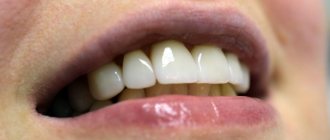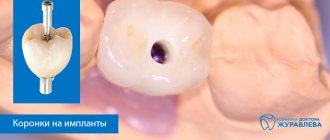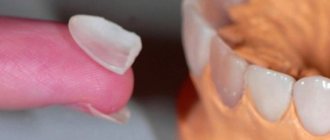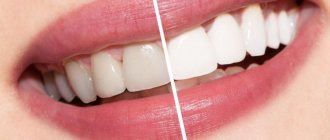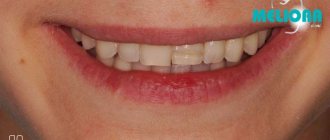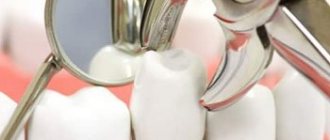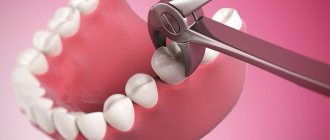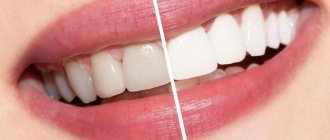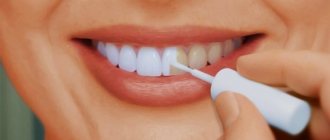Over the course of a person's life, cracks sometimes form in the enamel of teeth. It can break off, wear off, or become covered with irregularities. Visual errors sometimes haunt the patient from childhood. Having gained access to the possibilities of modern medicine, an adult strives to take advantage of them and add shine and shine to his own smile.
Therapeutic veneers are extremely popular as an alternative to invasive orthopedic intervention in the functionality of the anterior teeth. Due to their reasonable price, they have surpassed expensive ceramic linings in the popularity rankings. The advantages of the mentioned technique reconcile patients with some disadvantages, but the issue of the appropriateness of installing therapeutic veneers is always discussed with the doctor in advance.
What are therapeutic veneers
Therapeutic veneers are additionally called composite veneers due to their composition. Onlays consist of a special light-hardening material that allows you to smooth out roughness, breaks and cracks on the front surface of the tooth, or change its shape.
Another name for these veneers is direct. It is explained by the way the structure is installed. The component is layered onto the vestibular surface of the front teeth and is immediately corrected. This is a creative work that requires the dentist to have experience and artistic vision, and the ability to foresee the result. Direct veneers are created in the patient's mouth in 2-3 hours. Therefore, a person no longer has to wait many days before he gets a beautiful smile and returns to his daily activities transformed.
What types of veneers are used in aesthetic dentistry: by type of material
The main criterion for classifying overlays is the type of material used. Veneers can be ceramic, made from a composite mixture, etc. All types of overlays differ from each other. The varieties are also installed differently.
Ceramic veneers
Ceramic veneers require indirect prosthetics. They are pre-made in the laboratory and then placed on the patient.
Among the proposals for front teeth, emax veneers are recognized as one of the best. They are as durable as possible and look aesthetically pleasing. Unlike standard ceramic onlays, E-max is made from pressed lithium silicate ceramic. The composition was developed by the leading German company Ivoclar Vivodent.
Cast glass ceramics
Veneers are produced from cast ceramics, characterized by high performance and aesthetic properties. Their performance is superior in comparison with porcelain. The main advantage is that there is no need for preparation.
Hot press ceramics
Veneers of this type are produced using the injection molding method under high temperature. The results are durable microprostheses that are resistant to chewing loads. They are thin and light.
At the same time, the pads are hypoallergenic and more durable. The main disadvantage is the impressive cost.
Traditional feldspar ceramics
Such veneers are made from a special powder obtained during firing and subsequent cooling of the crushed workpiece. The material has high aesthetic characteristics. It is excellent for dental prosthetics, regardless of their location.
Composite veneers
Composite veneers are inexpensive. Their appearance is natural. Overlays are made from a special material that is applied in layers. They are distinguished by ease of installation, but the quality does not suffer from this.
Porcelain veneers (Hollywood laminates)
Porcelain veneers or lumineers are considered one of the main achievements in dentistry. They look like thin plates and are placed on the front of the teeth. The color of the overlay is selected by the patient together with the doctor. Veneers are simply glued on, after etching the surface of the natural tooth to make it rough.
Zirconium veneers with application
These overlays are formed from an alloy with zirconium. The material is highly durable and perfectly compatible with teeth. The effect of its use is excellent. The only negative is the high cost.
Plastic veneers (temporary)
Temporary veneers are used after the enamel has been prepared and impressions have been taken. It takes time to produce permanent overlays. During this period, already ground enamel looks ugly. To hide the defect, temporary overlays are used. They also perform the function of protecting teeth from bacteria, temperature, food and plaque.
Plastic veneers are attached with adhesive and can be easily removed in the dental office.
Removable veneers - they don’t exist
Are there removable veneers? In fact, there are none. The onlays, which appear in advertising every now and then, are attached to 10-12 teeth in a row. They are flat models with imitation gums. They are attached directly to the teeth.
Manufacturers claim that such overlays are suitable for any jaw. In practice, everything looks different.
Advantages and disadvantages of veneers using the direct method
The advantages of the technique are mainly associated with the relative simplicity and high speed of production of onlays:
- Veneers are installed in one clinic visit. No preliminary making of impressions, fitting or installation of temporary structures is required.
- The enamel is turned in a gentle way, to a depth of up to 0.7 mm, sometimes less. If the tooth is not sick, manipulations are kept to a minimum. For example, only part of the tooth is processed or no preparation is done at all.
- Modern photocomposite materials reliably imitate human dental tissue. As a result, the therapeutic veneer is practically indistinguishable from adjacent healthy teeth.
- Accidental damage to part of the veneer will not become an obstacle to correcting the situation. At the appointment, the doctor will remove the layered composition that has lost its usefulness and install a new one.
- The price of direct veneering is truly considered budgetary and is available to everyone, including students and retirees. Ceramic structures are much more expensive.
The latter circumstance often becomes decisive. However, along with the advantages, the doctor certainly voices the disadvantages of the technique, giving the person the opportunity to make an informed choice.
Dental restoration at Dentistoff Dentistry
The professionals at the Dentistoff scientific clinic always focus on methods that will allow your teeth to undergo minimal grinding, keeping them intact and alive.
Composite veneers will allow you to inexpensively and quickly eliminate tooth decay and defects, restoring not only a snow-white smile, but also self-confidence.
And the service and cozy atmosphere of the Dentistoff clinic, the high professionalism of the staff and the most modern techniques guarantee you a safe and painless aesthetic restoration.
Call now!
Obvious disadvantages of direct veneering:
- Therapeutic veneers gradually change shade. The microporous structure absorbs the pigments of food elements over the years and becomes darker. To prevent the development of such a situation, the patient must limit his own diet and try to avoid foods with bright, persistent enamel coloring. The list includes red wine, beets, strong tea, etc.
- Shorter service life compared to ceramic plates. This is explained by the loose fit of the composite to the tooth tissues, which provokes the accumulation of plaque in the lacunae and crevices. Bacteria readily inhabit these cavities, contributing to the development of caries.
- Hardness bordering on brittleness. Direct veneers crack when subjected to strong force and cannot be restored.
The listed disadvantages can be limited if you follow the rules of hygiene and take care of the installed veneer. Medical technologies do not stand still, and the first two disadvantages gradually cease to be decisive for the patient. The materials used are constantly improving the adhesive ability and expanding the possibilities of extending the service life.
Luxneers - veneers are installed without tooth preparation and without pain. Diastema, tremata, curvature, salts of teeth are corrected. It is advisable to bring a panoramic image of the OPTG to the consultation.
Is it possible to replace an old veneer with a new one?
There is no exact service life and replacement time for old linings. The shade of the existing plates simply changes or their surface becomes leaky, and caries begins under the composite (if ceramics are installed, the development of caries is practically excluded). The clinic removes the old structure, the cost of the procedure is 3900 rubles per tooth. And a replacement is immediately selected for them.
There are frequent requests from patients who once had composite veneers installed, but today they would like to change them to ceramic ones, including those made using CEREC technology. Emax veneers are of ideal quality and speed of production. A new Cerec veneer can be obtained in 1.5 hours, and such veneers do not require an adjustment period.
How to create a Cerec overlay:
- The enamel is processed and the tooth is scanned. No cast needed.
- A three-dimensional model of the overlay is created taking into account the physical data.
- An automatic machine turns a prosthesis from an array of pressed ceramics.
- The veneer should be tried on and fixed.
If questions arise or the shade does not match, a corrected copy will be received within a few minutes. But such cases are rare. Veneers are ideally fixed even on uneven teeth - if the installation work is carried out by an experienced specialist. The perfect fit of the plates prevents bacteria and food particles from getting under the lining.
Indications for installation of veneers
Therapeutic veneers are indicated when only the facial surface of the tooth is destroyed. If the problem lies in the side or back, a direct veneer is not sustainable.
Most often, a composite is used to cover cracked enamel, stains on the surface, or a noticeable boundary between the filling material and the living tissues of the tooth that arose during the treatment of caries. Sometimes in these cases the enamel is ground down locally, which reduces the area of trauma.
Direct veneers are excellent at hiding pigment spots that cannot be bleached. For example, indications for installing an onlay will be tetracycline teeth.
The increased sensitivity of teeth to whitening components will lose its significance if the tooth changes its shade to snow-white by layering the composite substance. It can correct the shape of a tooth, eliminate diastema, correct size, and eliminate minor curvature.
It happens that tooth enamel wears away over the years, then direct veneers will come to the rescue. They will also correct the situation with damaged enamel after wearing braces for a long time.
Service life of veneers
Depending on the manufacturing method, the service life of the finished product may vary. Thus, direct veneers can last up to 7 years, but after 2-3 years the aesthetic properties of such microprostheses deteriorate.
Ceramic veneers can last up to 20 years if properly cared for. It must be remembered that the service life of the product may be reduced if the structure is improperly manufactured and fixed. Therefore, it is worth contacting competent specialists. It should also be noted that you cannot “over-wear” the veneers, since after the expiration of their service life there is a risk of the plate falling out.
Veneers are a high-tech development with which you can quickly and easily get a perfect smile. The technology for manufacturing microprostheses is being improved from year to year, which makes it possible to reduce the degree of filing of the tooth surface, while obtaining excellent results.
Contraindications
However, in most cases, veneers will not replace the braces system. A thin plate cannot hold the tooth in an orthodontically correct position. Therefore, significant occlusion will become an obstacle to the application of a composite in order to improve the aesthetics of the dentition.
Addition to the list of contraindications:
- Teeth destroyed by caries. The installation of a veneer also excludes the case when the filling makes up a large part of the tooth, especially if it occupies almost the entire vestibular surface.
- Periodontal inflammation;
- Unsatisfactory hygienic condition of the oral cavity;
- Tendency to uncontrollable grinding of teeth, mainly in sleep;
- Engaging in contact sports (boxing, martial arts), when there is a high risk of breaking a fragile veneer;
- Indulging in the habit of cracking seeds with incisors, biting threads, etc.
Also, in most cases, the doctor will refuse to install a composite veneer on the surface of a chewing tooth, where the load on the component will be too great to ensure that it remains intact.
E-max ceramic veneers and zirconium dioxide
Metal-free veneers contain a frame made of lithium disilicate or zirconium dioxide. Such plates are almost transparent and have a fine structure. And unlike others, their service life increases to 25–30 years.
Pros of ceramic zirconium veneers
• Duration of operation is longer than that of porcelain;
• Lithium disilicate plates look natural, regardless of lighting;
• Color does not change after eating food coloring;
• Do not accumulate plaque if the rules of oral hygiene are ignored;
• Does not have a black coating when smoking;
• They are light in weight and thin, so wear off of the enamel is minimal.
Zirconium veneers, unlike composite plates, are placed on teeth, even in the most difficult clinical cases. Usually, they are inserted in the smile zone - on the 10 upper and 8 lower teeth.
The downside is that the insertion process takes longer due to the fact that the material is difficult to fix on the tooth surface.
Installation requires minor tooth grinding.
How direct veneers are installed
The installation of therapeutic veneers occurs directly during a visit to the dentist’s office.
- The doctor examines the condition of the patient’s teeth and collects information. If there are no obstacles, teeth are cleaned and tartar is removed. Sometimes preliminary treatment of caries is required, then the installation of veneers is postponed.
- The enamel is prepared to a small thickness, sometimes only locally, not over the entire surface of the tooth. At the patient's request, anesthesia is used; there is no need to endure pain.
- Then etching of the exposed area is used to improve the adhesion of the composite material to the tissues of the living tooth.
- The doctor applies the substance of the future veneer layer by layer onto the prepared tooth, simultaneously forming and fixing the composite. An LED or UV lamp is used for curing.
- Finally, grinding and final polishing are performed, as a result of which the tooth acquires the appearance of a natural one.
Some patients attribute the need to keep their mouth open for a long time as a subjective disadvantage. To prevent muscles from getting tired, the doctor uses intermaxillary inlays. However, you need to psychologically prepare for possible slight discomfort.
Price
| Included in the price |
|
| Paid separately |
|
| Affect the cost |
|
What happens after the procedure
The person leaves the clinic with a beautiful smile and returns to everyday life. In an effort to extend the service life of composite veneers, the patient is obliged to follow the recommendations of the attending physician. Oral hygiene is performed as usual, the constant use of floss is recommended, and a desire is expressed to buy an irrigator for better cleaning of teeth.
After 30 days, a follow-up appointment will follow, at which the dentist will examine the veneer and monitor the patient’s compliance with the rules of care. Once every six months, polishing of the composite will be required to maintain the presentable appearance of the lining. Of course, if the integrity of the veneer is compromised or there is suspicion of caries arising under the structure, an appointment with a doctor is required.
Duration of wearing veneers made of composite materials and caring for them
Unfortunately, the duration of wear of composite veneers is a significant criterion by which they will be inferior to ceramic veneers. Unlike the latter, which can last for decades, veneers made from composite materials need to be renewed approximately every 4 years. Regarding care, in addition to typical everyday hygiene with a toothbrush, toothpaste, floss and irrigator, veneers made of composite materials also require periodic polishing.
Therefore, you should not skip visits to the hygienist. You should not expose composite veneers to unnecessary mechanical influence: gnawing something or biting hard. Mouth guards can be worn at night to prevent inadvertent injury. Once every six months, it is recommended to visit a doctor so that he can professionally assess the condition of the veneers.
Caring for therapeutic veneers
Aspects and rationales for care relate to the intricacies of the composition and installation of therapeutic veneers. Recommended:
- Avoid putting pressure on teeth with onlays;
- Minimize the content of brightly colored foods and drinks with dyes in the diet;
- Love hygiene and carefully observe it;
- Visit your dentist regularly.
Composite veneers come in handy when you want to quickly and inexpensively transform your smile. If the defects are not too strong and there are no contraindications, it is worth taking advantage of the achievements of dentistry and changing the appearance of the teeth.
Should I get composite veneers?
The main purpose of veneers made of composite material is to correct minor irregularities in the dentition, chipped enamel, large gaps between the front teeth and small cracks. Composite veneers do an excellent job of removing unsightly color that cannot be bleached. However, this is important if it concerns one or two teeth. If you need to radically solve the aesthetic problems of the entire smile area, then ceramic veneers are the ideal solution.
